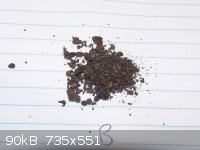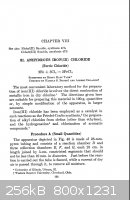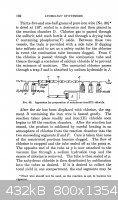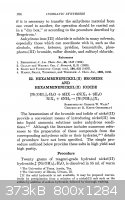BenZeen
Harmless

Posts: 37
Registered: 15-1-2010
Member Is Offline
Mood: No Mood
|
|
Anhydrous FeCl3 (attempt)
Hi everyone,
after reading a few posts about anhydrous aluminium and iron compounds i decided to try and make FeCl3 myself. First method was with HCl + Fe (steel
wool - fine grade) and then H2O2 which immediatly turned the green solution brown. I didn't have enough H2O2 to add an excess, so i let it sit for a
few days with shaking before heating the whole solution to dryness. alot of HCl gas was evolved from the solid as it was being dried (not pleasant)
and below is the result. "A" is made from HCl + Fe + H2O2, "B" is from the Cl2 + Fe + heat method.
My next attempt involved stuffing copper pipe with steel wool and heating to around 300 C before passing Cl2 gas through it. The excess Cl2 was
bubbled into strong NaOH solution. This continued for about half an hour with no sign of Iron chloride vapour passing out the end of the tube so i
shut it down and let it cool before dismantling the setup. The pipe was full of "stuff" clinging to the walls so i managed to scrape out the contents
and collect a few grams of what appears to be FeCl3 judging by some photos i have seen of it. All of the steel wool reacted but it managed to stay
inside the pipe, which i think isn't so bad as condensing vapours of Al/FeCl3 is a pita. It is very hygroscopic, melting into a yellow liquid within
minutes of exposure to air.
I think the first compound i made is mostly now Fe2O3 after heating it to dryness (and its rusty colour), but i am fairly confident that the second
attempt may have produced anhydrous FeCl3. Any comments/opinions are always welcome - Benz


|
|
|
IrC
International Hazard
    
Posts: 2710
Registered: 7-3-2005
Location: Eureka
Member Is Offline
Mood: Discovering
|
|
Not an expert like Woelen but it does not appear like you are correct. I have pounds of the stuff I use all the time making etchant and your pics do
not look like anything other than various stages of rust. Possibly in the 2nd pic you have a trace of it plus rust. Good attempts however keep trying
and keep us posted I love experiments like this. Makes life worth living!
Edit to correct Woolen to Woelen.
[Edited on 4-26-2011 by IrC]
"Science is the belief in the ignorance of the experts" Richard Feynman
|
|
|
woelen
Super Administrator
        
Posts: 8027
Registered: 20-8-2005
Location: Netherlands
Member Is Offline
Mood: interested
|
|
Anhydrous FeCl3 is black with a somewhat metallic looking luster. It actually looks a little bit like elemental iodine, albeit somewhat darker.
Your pictures do not really look like FeCl3, not the anhydrous material, nor the hydrated form, which is yellow/brown (a color, somewhat like
mustard).
It is almost impossible to make anhydrous FeCl3 from an aqueous solution. FeCl3 is so strongly attracting water and is so easily hydrolysed that any
attempt to boil off water will result in loss of HCl and formation of Fe(OH)3 or even Fe2O3 if heating is stronger.
One way to make anhydrous FeCl3 is by passing dry chlorine over finely divided and somewhat heated Fe. Another way _might_ be leading dry HCl over Fe,
but I'm afraid that this mainly gives FeCl2 instead of FeCl3. You may also succeed in making FeCl3 if you take finely powdered Fe, suspended in dry
DCM or CHCl3 and lead dry Cl2 through this liquid. The Cl2 will dissolve in the organic liquid and react with the finely divided Fe. In this way, I
have made SnI4 from finely divided Sn and I2. Fe and Cl2 both are more reactive, so I give this reaction a good chance. FeCl3 is a covalent compound
and I expect it to be soluble in something like CHCl3.
|
|
|
BenZeen
Harmless

Posts: 37
Registered: 15-1-2010
Member Is Offline
Mood: No Mood
|
|
Thanks for the replies,
I will try the chlorination of DCM with steel wool shortly and post the results, as this experiment sounds easy and the materials are easy for me to
get.
The compound in the second photo looks exactly like the black FeCl3 (anhydrous) pictures on google image search when "anhydrous ferric chloride" is
searched, its actually alot darker than the photo shows, and sparkles like little crystals. But the whole stup is annoying and if Dcm + Cl2 works,
then it sounds alot better.
Cheers!
|
|
|
IrC
International Hazard
    
Posts: 2710
Registered: 7-3-2005
Location: Eureka
Member Is Offline
Mood: Discovering
|
|
I would search this site carefully to save yourself a lot of work. A couple of years ago or so there was a long conversation on this subject, with
replies by several of the real experts like Woelen, and I remember the consensus was get the water out of your reactions or you will fail.
"Science is the belief in the ignorance of the experts" Richard Feynman
|
|
|
woelen
Super Administrator
        
Posts: 8027
Registered: 20-8-2005
Location: Netherlands
Member Is Offline
Mood: interested
|
|
Quote: Originally posted by BenZeen  | Thanks for the replies,
I will try the chlorination of DCM with steel wool shortly and post the results, as this experiment sounds easy and the materials are easy for me to
get.
The compound in the second photo looks exactly like the black FeCl3 (anhydrous) pictures on google image search when "anhydrous ferric chloride" is
searched, its actually alot darker than the photo shows, and sparkles like little crystals. But the whole stup is annoying and if Dcm + Cl2 works,
then it sounds alot better.
Cheers! |
You can easily test for the presence of FeCl3. Put a sample of your material in acetone. If it
contains anhydrous FeCl3 then part of it will dissolve in acetone. If it only is oxide, then the solid quickly will settle and the acetone remains
colorless.
|
|
|
ItalianChemist
Hazard to Others
  
Posts: 172
Registered: 26-1-2011
Location: Italy
Member Is Offline
Mood: No Mood
|
|
If FeCl3 is heated to dry, it will form iron(III) oxychloride releasing chlorine gas.
The reaction between Fe and anhydrous chlorine gas is the best way to produce anhydrous FeCl3, you can purify the final product sublimating it in
reduced pressure.
|
|
|
BenZeen
Harmless

Posts: 37
Registered: 15-1-2010
Member Is Offline
Mood: No Mood
|
|
Hi,
I gave the dichloromethane + Fe + Cl2 method a go, in about 400ml of dcm was placed a few grams of steel wool and it was setup for Cl2 addition
through a gas inlet tube several cm above the mix. Slowly the dcm turned yellow and tiny bubbles were seen coming off the Fe. I continued feeding Cl2
into the flask until it appeared that no matter how much Cl2 i added, the reaction wasn't appearing to go anywhere so i shut it down and stoppered the
flask. 24 hours later the mix has become alot darker but there is still most of the steel wool remaining and the reaction appears to have failed. The
amount of chlorine added just to get it to this stage is large, and if more was needed just to get a few grams of Fe to react then i would say it is
not a feasible route to get anhydrous FeCl3. However, Judging by the colour of the dcm though it appears that some FeCl3 was made.
 
|
|
|
woelen
Super Administrator
        
Posts: 8027
Registered: 20-8-2005
Location: Netherlands
Member Is Offline
Mood: interested
|
|
You certainly have some FeCl3 in that DCM, it is quite dark brown/yellow and that is the color of dissolved FeCl3. It also truly is anhydrous FeCl3.
Hydrated FeCl3 is a salt and that does not dissolve at all in DCM.
But why did you do the experiment on such a large scale? You could have taken 10 ml of DCM, a little steel wool plucked from a larger piece and a
small amount of Cl2 lead in with a glass tube. I always use miniature/micro scale when I first try something and then lateron, if I decide to
synthesize something, I scale up.
Does the DCM have a strong smell of Cl2? If not, then all Cl2 is used up and you can try leading in more Cl2.
|
|
|
BenZeen
Harmless

Posts: 37
Registered: 15-1-2010
Member Is Offline
Mood: No Mood
|
|
Hi,
Thanks for the feedback Woelen, You are right about the scale, it is far too eager for a first time experiment. I tried to dissolve what i produced
from the Cu pipe, Fe + Cl2 and it partially dissolved to give a yellow solution in the acetone, but there was alot of brown solid left behind. Clearly
it was heavily contaminated with oxides and other things. I will attempt to pump more Cl2 through the mix at a latter date, however the romance
between Chlorine and I has withered and died and the prospect of working with it no longer excites me...its not a pleasant substance. Any ideas about
speeding up the reaction? heating is not an option, due to dcm boiling point and massive plumes of Cl2 that are released from the solvent. Perhaps
cooling the mix would allow more Cl2 to be dissolved and this could bring the reaction forward? cheers
|
|
|
The WiZard is In
International Hazard
    
Posts: 1617
Registered: 3-4-2010
Member Is Offline
Mood: No Mood
|
|
Quote: Originally posted by BenZeen  | Hi everyone,
after reading a few posts about anhydrous aluminium and iron compounds i decided to try and make FeCl3 myself. |
This reminds me of an old adage about making Bear Stew —
First — you have to shoot the bear. Well — here first you
have to make anhydrous chlorine The chemistry of making iron
chloride is elemental — the Devil in the chemical engineering. Now
before the details another old adage — 30 minutes in the library
will often save 30 day in the lab. There are two premier books
on inorganic synthesis :—
Bauer's two volume Handbook of Preparative Inorganic Chemisty
it took me years to find a copy that I could afford... you can now
DL copies from the Form Library among other places.
The multi-volume - continuing Inorganic Synthesis series. I
have scanned the method from IS Volume III as it has illustrations.
   
|
|
|
xwinorb
Hazard to Others
  
Posts: 100
Registered: 9-8-2005
Member Is Offline
Mood: No Mood
|
|
I totally agree with woelen ( see third post on this thread ) on the appearance of the FeCl3. I have bought 100 g of it. It looks black, kind of wet
powder, and I had a small patch of yellowish looking powder mixed in at the top cap.
I scrubbed out most of the yellow colored powder, which seems to be the hydrated salt. I removed some yellow spots mixed in also.
I have one question, can FeCl3 be dried with drierite ?
For instance, placing the FeCl3 bottle slightly open, inside a bigger air tight container with drierite ?
Thank you.
xw.
|
|
|
IrC
International Hazard
    
Posts: 2710
Registered: 7-3-2005
Location: Eureka
Member Is Offline
Mood: Discovering
|
|
Easy test is mix some in water. If it leaves a nitric appearing yellow stain on your finger or clothes which is impossible to wash off, and heats the
water, you are there.
"Science is the belief in the ignorance of the experts" Richard Feynman
|
|
|
Mumbles
Hazard to Others
  
Posts: 436
Registered: 12-3-2003
Location: US
Member Is Offline
Mood: Procrastinating
|
|
Quote: Originally posted by xwinorb  | I totally agree with woelen ( see third post on this thread ) on the appearance of the FeCl3. I have bought 100 g of it. It looks black, kind of wet
powder, and I had a small patch of yellowish looking powder mixed in at the top cap.
I scrubbed out most of the yellow colored powder, which seems to be the hydrated salt. I removed some yellow spots mixed in also.
I have one question, can FeCl3 be dried with drierite ?
For instance, placing the FeCl3 bottle slightly open, inside a bigger air tight container with drierite ?
Thank you.
xw.
|
If you mean from a hydrated form, then no. It requires much more aggressive dessicating agents, such as Thionyl Chloride. You might be able to heat
it in an atmosphere of HCl or chlorine or something too.
|
|
|
AJKOER
Radically Dubious
    
Posts: 3026
Registered: 7-5-2011
Member Is Offline
Mood: No Mood
|
|
I noticed that FeCl3 is soluble in Ethanol (as is water).
So would adding Ethanol to a solution of FeCl3 in water and letting it evaporate on its own, yield the anhydrous FeCl3?
Or, is the only way starting with the hydrated form, by means of Thionyl Chloride?
FeCl3·6H2O + 6 SOCl2 → FeCl3 + 6 SO2 + 12 HCl
Thanks
|
|
|